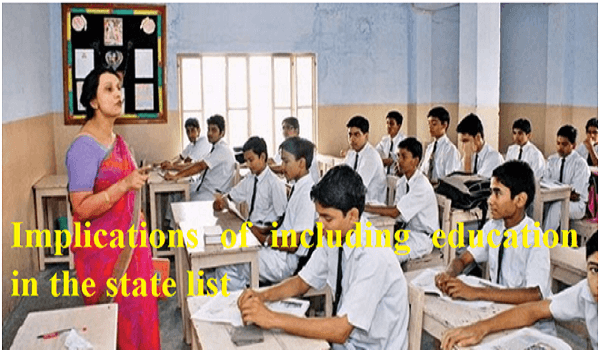Recently, the UGC-NET exam has been cancelled due to the allegations of paper leak in NEET-UG exam, while CSIR-NET and NEET-PG exams have been postponed. To deal with such situations, various experts have opined in favour of including education in the state list.
Historical background
Federal structure during British rule
- The Government of India Act, 1935 during British rule laid the foundation of federal structure in Indian politics.
- Legislative subjects were distributed between the federal legislature (present Union) and the provinces (present State). Education, which is an important public subject, was placed in the provincial list.
Post-independence scenario
- Although this continued even after independence and education, under the Seventh Schedule of the Constitution, was part of the ‘State List’ subject to distribution of powers. This means that individual states have the primary responsibility for managing their education system.
Emergency and Swaran Singh Committee
- During the Emergency, the Congress Party set up the Swaran Singh Committee to provide recommendations for amendments to the Constitution. One of the recommendations of this committee was to place ‘Education’ in the Concurrent List, so that all-India policies could be developed on the subject.
- This was subsequently implemented through the 42nd Constitutional Amendment (1976) by moving ‘Education’ from the State List to the Concurrent List. No detailed rationale was given for this change, and the amendment was ratified by various states without any substantial debate.
Attempts by the Janata Party Government
- The Morarji Desai-led Janata Party government, which came to power after the Emergency, passed the 44th Constitutional Amendment (1978) to reverse many of the controversial changes made through the 42nd Amendment. One of these amendments, which was passed in the Lok Sabha but not in the Rajya Sabha, was to bring ‘Education’ back into the State List.
Adding education to the concurrent list
- During the emergency, the Congress party set up the Swaran Singh Committee to make recommendations for constitutional amendments. The recommendations of this committee included placing ‘education’ in the concurrent list so that all-India policies could be developed on the subject.
- Through the 42nd Constitutional Amendment (1976), ‘education’ was moved from the state list to the concurrent list. However, no detailed rationale was given for this change and the amendment was ratified by various states without adequate debate.
Education system at international level
- In the US, state and local governments set overall educational standards, mandate standardized testing, and monitor colleges and universities. The functions of the federal Department of Education mainly include formulating policies for financial aid, focusing on key educational issues, and ensuring equal access.
- In Canada, education is managed entirely by the provinces. The German constitution places legislative powers for education with the Landers (equivalent to states).
- Education in South Africa is regulated by two national departments dealing with school and higher education. The country’s provinces have their own education departments to implement the policies of the national departments and deal with local issues.
Arguments in favour of inclusion in the State List
- Arguments in favour of ‘education’ in the Concurrent List include a uniform education policy, improvement in standards and synergy between the Centre and the states. However, a ‘one size fits all’ approach is neither possible nor desirable given the vast diversity of the country. Therefore, both sides of it should be considered collectively.
- According to the ‘Analysis of Budgetary Expenditure on Education’ report prepared by the Ministry of Education in the year 2022, the total revenue expenditure by education departments in India is estimated to be ₹6.25 lakh crore (2020-21). Of this, 15% is spent by the Centre while 85% is spent by the states.
- A meaningful discussion is needed to reintroduce ‘Education’ in the State List, keeping in view the need for autonomy given the large share of expenditure being borne by the States.
- Central institutions like the National Medical Commission, University Grants Commission and All India Council for Technical Education can be continued as regulatory mechanisms for higher education.
- These will be able to formulate policies for curriculum, testing and admissions to higher education, including professional courses like medicine and engineering.
Constitutional Provisions for Education
- Education in the Indian Constitution is initially addressed by Article 45 of the Directive Principles of State Policy.
- Article 45 mandates the State to endeavour to provide for free and compulsory education for children up to the age of fourteen within ten years of the commencement of the Constitution.
- The 6th Amendment introduced Article 21-A, making free and compulsory education for children between the ages of six and fourteen a fundamental right.
- The Right of Children to Free and Compulsory Education (RTE) Act, 2009 was enacted by the Centre to implement Article 21-A.
- Originally under the State List of the 7th Schedule, education was placed in the Concurrent List by the 42nd Constitutional Amendment.

